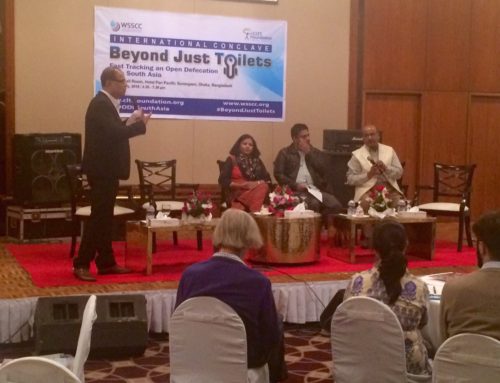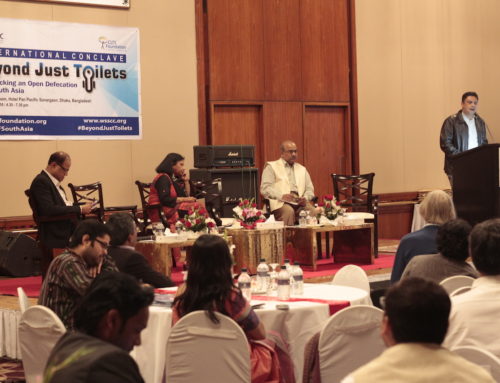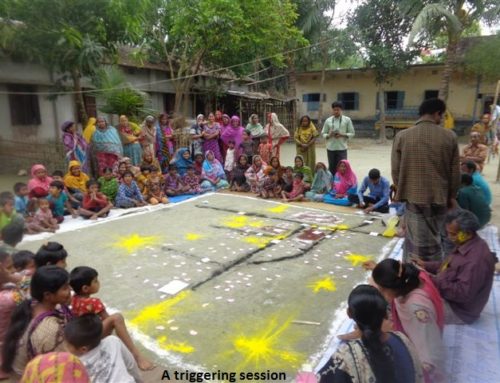The atmosphere is upbeat in Tipakhol, a remote tribal village in Chhattisgarh, as women gather to narrate their sanitation story: How all the 70-odd families used to climb up and down a distant hill to answer the nature’s call, spending, at least, an hour every day in the process, and how everything changed in a matter of just two weeks.
Tipakhol is one of the first few villages in Raigarh district that have become open-defecation-free (ODF). The transformation in the village has not only liberated men and women from the age-old practice of open defecation but has also empowered marginalized groups. “We constructed our toilets using our own money and locally available materials like bamboo and stones,” said Parvati Naik, a middle-aged woman with a veil. “If we could end open defecation in our village, we can also end alcohol abuse and other vices that have been the bane of our populace,” Parvati continued. She not only constructed her own toilet but also supported the entire village in becoming ODF.
The successful sanitation movement in Tipakhol has brought to light people’s power to bring about changes in their lives through collective effort. “This is the power of community-driven approaches,” said Mr. Durga Naik, a block coordinator in Raigarh district and master trainer of the community-led total sanitation (CLTS) approach. “Until recently, women were not even taking part in village-level meetings. Now, it is a matter of pride they actively participate in the development of the village,” he said.
In the recent past, 55 villages and 16 gram panchayats have been declared ODF in Raigarh district through the CLTS approach. CLTS consists of “trigger tools” to awaken the communities. One of the tools is used to show them how flies take off from open defecation spots, travel straight and desecrate their drinking water and food. This leads to realization and a sense of unity and collective responsibility to solve their problems and ultimately ensure a transformation.
However, CLTS method alone is not enough to achieve village-level changes. The administration has to work hand in hand with the communities to facilitate the process of change. Nilesh Kshirsagar, the Indian Administrative Service (I.A.S.) officer, set up a district-level team to scale up the sanitation campaign when he was CEO of Raigarh Zila Parishad. “Once the demand for toilets is created, we encourage communities to build toilets using their own money. This leads to commitment and ownership which in turn results in higher usage. After a village is declared ODF, we transfer the subsidy amount to the village for community development”, Kshirsagar said. Despite the CEO’s transfer, the people who worked closely with him continue to take the campaign to other villages. The CEO’s official driver has become a strong believer of community-led movements and now doubles up as a sanitation motivator in villages.

Mithlesh Sevta in the center accompanied by the Navratn and other villagers in Brahman Bedi
Raigarh is not the lone district in Chhattisgarh working on sanitation. Many other districts have joined the crusade. Rajnandgaon district, which was facing slippages in its sanitation performance, decided to scrap the subsidy-driven approach and switch to CLTS. In Brahman Bedi, a sleepy tribal village in Rajnandgaon, the movement is led by a differently-abled boy, Mithlesh Sevta. He takes his tricycle, painted with sanitation messages to every nook and corner to create awareness. Supported by the “Navratn”, a team of nine gems from the village, he also plays songs in the local language to educate villagers.
In Dakko Tola, another village in Rajnandgaon, a local mason, Kushal Singh, narrated the transformative process in his village. “Space was a constraint in some of the households. But that did not stop us from constructing toilets. People constructed toilets within their homes, next to the kitchen, or in the cow-shed, thereby breaking free from age-old beliefs”, Singh said. Dakko Tola which became ODF a year ago has come up with the unique idea of installing a “Bachat Bank” (Savings Bank) outside household toilets. Households make use of the money collected in the piggy bank for repair of toilets as well as buying hygiene and health products.
So far, 187 gram panchayats have been declared ODF in Rajnandgaon. Like Raigarh, the efforts in Rajnandgaon are also driven by local champions. “While we create a conducive environment for change at the district-level by passing the necessary guidelines and orders, we allow communities to take charge in the field. Whenever I get a chance, I personally visit the villages to speak about sanitation”, said Mukesh Bansal, I.A.S, Collector, Rajnandgaon, who believes constant communication with the households is the key to transformation.

Kushal Singh, the local mason of ODF Dakko Tola, poses in front of his toilet along with the Bachat Bank on his right.
In the recent past, Chhattisgarh has seen the birth of many such inspiring stories. In Sarguja district, for instance, sanitation has led to livelihood opportunities for women groups which are busy manufacturing bricks that can be used for toilet construction. Padmashree Phool Basan who leads a wide network of 12,000 self-help groups with over 2,00,000 members said in an interview that the sanitation movements can also be leveraged for new livelihood opportunities for women. “We need some training on the technical and marketing aspects of producing eco-friendly hygiene products like soaps, detergents, and sanitary napkins”, Ms. Yadav said.
While districts have been busy with their campaigns, their success has depended heavily on state-level support for such reforms. A number of enabling guidelines have been passed at the state-level paving way for faster reforms at the district-level. “We have circulated several notes and guidelines to the districts which carry the implementation details, the technological aspects of constructing toilets as well as information on monitoring of performances”, M. Geetha I.A.S, Mission Director, Swachh Bharat Mission, Government of Chhattisgarh said. “Once the state decided to adopt the CLTS approach, it became easier for the districts to follow suit”, she said.

Parvati Naik in front of her toilet in Tipakhol village.
Somya Sethuraman is a sanitation expert and has worked with several local and international organizations that specialize in the provision of water and sanitation.
This article was first published at Swarajyamag. It was part of a media advocacy partnership between WSSCC, Geneva and CLTS Foundation Global.






Leave A Comment